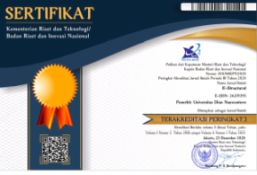Synchronizing between Lasswell’s Communication Model and Abram’s Critical Orientation as a Sophisticated Concept of Literary Communication and Its Associated Studies
Abstract
Abstract. This scientific article is entitled "Synchronizing between Lasswell's Communication Model and Abrams' Critical Orientation as a Sophisticated Concept of Literary Communication and Its Associated Studies". By using a multidisciplinary study, one study in solving a problem using various points of view of many relevant sciences in this case, such as literature and communication science, the research question of this article is synchronizing between Lasswell’s Communication Model and Abrams' Critical Orientation as a Sophisticated Concept of Literary Communication and Its Associated Studies. The literature review used as a scientific foundation in conducting this theoretical review, among others, is Nature of Literature and Literary Works, Sigmund Freud’s Psychoanalytic: Mind Structure and Topography, Intertextuality Act, Mayer Howard Abrams’ Critical Orientation, and Harold Dwight Lasswell’s Communication Model. The design of this article represents a theoretical review of a comparative study between communication science and literary studies. The technique of data analysis used is Lasswell's model to describe components of literary communication and its associated studies. The results of this article are the components of literary communication consisting of the source as the ideas, the artist as the communicator, the main idea in literary work as the message, the figurative language as media, and the audience as the receiver, and impact as the effect. The studies of each component are that mimetic, expressive, objective, and pragmatic studies.
Keywords: communication, component, model, studies, synchronizing
Abstrak. Artikel ilmiah ini berjudul "Sinkronisasi antara Model Komunikasi Lasswell dan Orientasi Kritis Abrams sebagai Konsep Canggih Komunikasi Sastra dan Studi Terkait". Dengan menggunakan studi multidisiplin, satu studi dalam memecahkan masalah menggunakan berbagai sudut pandang banyak ilmu yang relevan dalam kasus ini, seperti sastra dan ilmu komunikasi, pertanyaan penelitian dari artikel ini adalah sinkronisasi antara Model Komunikasi Lasswell dan Orientasi Kritis Abrams sebagai Konsep Canggih Komunikasi Sastra dan Studi Terkait. Tinjauan literatur yang digunakan sebagai landasan ilmiah dalam melakukan tinjauan teoretis ini, antara lain adalah Sifat Karya Sastra dan Sastra, Psikoanalitik Sigmund Freud: Struktur dan Topografi Pikiran, Tindakan Antartekstualitas, Orientasi Kritis Mayer Howard Abrams, dan Model Komunikasi Harold Dwight Lasswell . Desain artikel ini merupakan tinjauan teoritis studi banding antara ilmu komunikasi dan studi sastra. Teknik analisis data yang digunakan adalah model Lasswell untuk menggambarkan komponen komunikasi sastra dan studi terkaitnya. Hasil dari artikel ini adalah komponen komunikasi sastra yang terdiri dari sumber sebagai ide, artis sebagai komunikator, ide utama dalam karya sastra sebagai pesan, bahasa kiasan sebagai media, dan audiens sebagai penerima, dan dampak sebagai efek. Studi masing-masing komponen adalah studi mimesis, ekspresif, objektif, dan pragmatis.
Kata kunci: komunikasi, komponen, model, studi, sinkronisasi
Full Text:
PDFReferences
Abrams, M.H. (1953). The Mirror and The Lamp: Romantic theory and Critical Tradition. London: Oxford University Press.
Allen, Graham.(2000). Intertextuality. London: Graham Allen. Berger. Charles R, Michael E Roloff, and David R Roskos-Ewoldsen. (2010). The Handbook of Communication Science. Californisa: Sage.
Bressler, Charles. 1999. Literary Criticism.United State of America; Prentice-Hall International UK, London.
Damono, Sapardi Djoko. (1978). Sosiologi Sastra Sebuah Pengantar Ringkas. Jakarta: Pusat Pembinaan dan Pengembangan Bahasa
Esten, Mursal. (1978). Kesusastraan : Pengantar, Teori dan Sejarah. Bandung : Angkasa
Fiske, John. 1990. Introduction to Communication Studies. London: Routledge.
Foucault, Michel. 1974. The Archaeology of Knowledge. London: Tavistock.
Freaud, Sigmund. (1989). An Outline of Psycho-Analysis. New York, London: WW. Norton and Company.
Klarer, Mario. 1999. An Introduction to Literary Studies. London: Routledge.
Lasswell, H. D. (1948). The Structure and Function of Communication in Society.
Bryson (Ed.). The Communication of Ideas (Pp. 37-51). New York: Harper and Row. Retrieved from https://pracownik.kul.pl/files/37108/public/Lasswell.pdf
Luxemburg, Jan van, et al. (1989). Pengantar Ilmu Sastra. Translated by Dick Hartoko.
Jakarta: Gramedia.
McCombs, Maxwell and Donald L. Shaw. (2010). Lasswell’s Communication Model.
Communication Theory. Retrieved from: http://communicationtheory.org/lasswells-model/.on Dec 2 2013.
Mikics, David. (2007). A New Handbook of Literary Term. London: Yale University Press.
Nurudin. (2005). Sistem Komunikasi Indonesia. Yogyakarta : Bigraf Publishing.
Plett, Heinrich F (ed). 1991. Intertextuality. Berlin and New York: Walter de Gruyter.
Pradopo, Rachmat Djoko. (2002). Kritik Sastra Indonesia Modern. Yogyakarta: Gama Media.
Pradopo, Rachmat Djoko. (2005). Beberapa Teori Sastra, Metode Kritik, dan Penerapannya. Yogyakarta: Pustaka Pelajar.
Pradopo, Rahmat Djoko. (2010). Pengkajian Puisi. Yogyakarta: Gadjah Mada University
Press.
Rakhmat, Jalaluddin. (1984). Psikologi Komunikas. Bandung : PT Remaja Rosdakarya.
Ratna, Nyoman Kutha. (2008). Teori, Metode, dan Teknik Penelitian Sastra: dari Strukturalisme hingga Postrukturalisme, Prespektif Wacana Naratif. Yogyakarta: Pustaka Pelajar.
Riffaterre, Michael. (1978). Semiotics of Poetry. Bloomington and Indiana: University Press.
Sarumpet, Riri K Toha. (2010). Pedoman Pendidikan Sastra Anak. Jakarta: Yayasan Pustaka Obor Indonesia.
Segers, Rien T. (2000). Evaluasi Teks Sastra. Translated by Suminto A. Sayuti. Yogyakarta: Adi Cita.
Semi, M Atar. (1984). Anatomi Sastra. Padang: FPBSIKIP.
Siswanto, Wahyudi. (2008). Pengantar Teori Sastra. Malang: GRASINDO.
Steinberg, Sheila. (2007). An Introduction to Communication Studies. Cape Town: Juta&Co.
Shoemaker, Pamela. Tankard Jr., J.; Lasorsa, D. 2004. How to Build Social Science Theories. Thousand Oaks: Sage Publications.
Sumardjo, Jacob. Saini K.M. (1997). Apresiasi Kesusastraan. Jakarta: Gramedia.
Saryo no. (2009). Pengantar Apresiasi Sastra. Malang: Universitas Negeri Malang.
Teeuw, A. (1991). Sastra dan Ilmu Sastra dan Pengantar Teori Sastra. Jakarta: Pustaka Jaya.
Van Rooden, A. ( 2012). Magnifying the Mirror and the Lamp: A Critical Reconsideration of the Abramsian Poetical model and Its Contibution to The Research on Modern Dutch Literature. Journal of Dutch Literature, 3(1), 65-87. Retrieved from https://pure.uva.nl/ws/files/1181761/116638_Van_Rooden_Magnifying_the_Mirror_and_the_Lamp.pdf
Widjaja, H. A. W. (2000). Ilmu Komunikasi Pengantar Studi, Jakarta : PT Rineka Cipta.
Wenxiu, Peng. (2015). Analysis of New Media Communication Based on Lasswell’s “5W†Model. Journal of Educational and Social Researc Vol. 5 No.3 ISSN 2240-0524. Doi:10.5901/jesr.2015.v5n3p245. Rome-Italy: MCSER Publishing.
Wellek, Rene and Austin Warren. 1984. Theory of Literature. San Diego, New York, London: Harcourt Brace and Company.
Worton, Micheal. Judith Still (eds). 1990. Intertextuality: Theories and Practices. Manchester: Manchester University Press.
DOI: https://doi.org/10.33633/es.v2i2.3263
Article Metrics
Abstract view : 571 timesPDF - 608 times
Refbacks
- There are currently no refbacks.
Accredited by:
Indexed by:
In Collaboration with:

This work is licensed under a Creative Commons Attribution 4.0 International License.

























